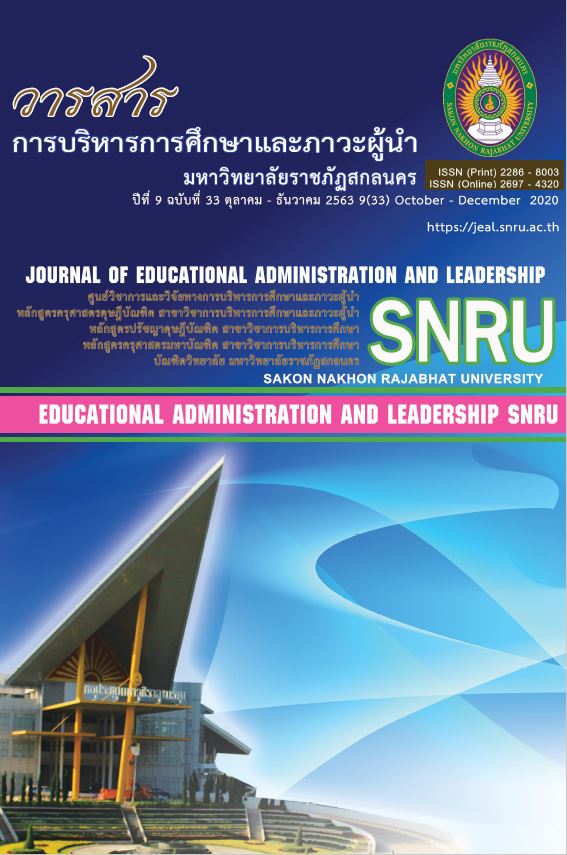

สภาพ ปัญหา และแนวทางการพัฒนาการบริหารความเสี่ยงของสถานศึกษา ในสังกัดสำนักงานส่งเสริมการศึกษานอกระบบ และการศึกษาตามอัธยาศัยจังหวัดสกลนคร
Conditions, Problems and Guidelines for Developing School Risk Management under the Sakon Nakhon Provincial Office of Non-Formal and Informal Education
ผู้แต่ง
อานนท์ พลไชย, สุรัตน์ ดวงชาทม, รัชฎาพร งอยภูธร
Author
Arnon Polchai, Surat Dungchatom, Ratchadaporn Ngoiphuthorn
บทคัดย่อ
การวิจัยครั้งนี้มีความมุ่งหมายเพื่อศึกษาสภาพ ปัญหา การเปรียบเทียบสภาพ ปัญหา และหาแนวทางการพัฒนาการบริหารความเสี่ยงของสถานศึกษา ตามความคิดเห็นของผู้บริหารสถานศึกษา ข้าราชการครู ครูอาสาสมัครการศึกษานอกโรงเรียน ครูการศึกษานอกโรงเรียนตำบล และครูศูนย์การเรียนชุมชน ในสังกัดสำนักงานส่งเสริมการศึกษานอกระบบและการศึกษาตามอัธยาศัยจังหวัดสกลนคร ปีการศึกษา 2562 จำแนกตามสถานภาพตำแหน่ง ประสบการณ์ในตำแหน่ง และขนาดสถานศึกษาที่แตกต่างกัน ซึ่งได้กำหนดขนาดของกลุ่มตัวอย่างโดยใช้ตารางของเครจซี่และมอร์แกน จำนวน 191 คน เครื่องมือที่ใช้ในการวิจัยมีลักษณะเป็นแบบสอบถามและแบบสัมภาษณ์ มีค่าดัชนีความสอดคล้อง (IOC) เท่ากับ 1.00 ซึ่งสภาพการบริหารความเสี่ยง มีค่าอำนาจจำแนกเท่ากับ 0.87-0.96 ค่าความเชื่อมั่น เท่ากับ 0.996 และปัญหาการบริหารความเสี่ยง มีค่าอำนาจจำแนก เท่ากับ 0.62-0.92 ค่าความเชื่อมั่น เท่ากับ 0.987 สถิติที่ใช้ในการวิเคราะห์ข้อมูล ได้แก่ ค่าร้อยละ ค่าเฉลี่ย และส่วนเบี่ยงแบนมาตรฐาน การวิเคราะห์ความแปรปรวนทางเดียวและวิเคราะห์เชิงคุณภาพ
ผลการวิจัย พบว่า
1. สภาพการบริหารความเสี่ยงของสถานศึกษา อยู่ในระดับมาก และปัญหาการบริหารความเสี่ยงของสถานศึกษา อยู่ในระดับปานกลาง
2. เปรียบเทียบระดับสภาพการบริหารความเสี่ยงของสถานศึกษาจำแนกตามสถานภาพตำแหน่งแตกต่างกัน ไม่มีความแตกต่างกัน และเปรียบเทียบระดับปัญหาการบริหารความเสี่ยงของสถานศึกษา จำแนกตามสถานภาพตำแหน่งแตกต่างกัน มีความแตกต่างกัน อย่างมีนัยสำคัญทางสถิติที่ระดับ .05
3. เปรียบเทียบระดับสภาพ ปัญหาการบริหารความเสี่ยงของสถานศึกษาจำแนกตามประสบการณ์ในตำแหน่งแตกต่างกัน ไม่มีความแตกต่างกัน
4. เปรียบเทียบระดับสภาพการบริหารความเสี่ยงของสถานศึกษาจำแนกตามขนาดสถานศึกษาแตกต่างกัน มีความแตกต่างกัน อย่างมีนัยสำคัญทางสถิติที่ระดับ .05 และเปรียบเทียบระดับปัญหาการบริหารความเสี่ยงของสถานศึกษา จำแนกตามขนาดสถานศึกษาแตกต่างกัน มีความแตกต่างกัน อย่างมีนัยสำคัญทางสถิติที่ระดับ .01
5. แนวทางการพัฒนาการบริหารความเสี่ยงของสถานศึกษา จำนวน 2 ด้าน ได้แก่ ด้านกลยุทธ์ และด้านการดำเนินงาน
5.1 ด้านกลยุทธ์ สถานศึกษาต้องมีวิสัยทัศน์และเป้าหมายที่ชัดเจน เป็นไปตามนโยบายที่กำหนด มีการติดตามผลการดำเนินงานตามกลยุทธ์อย่างต่อเนื่อง
5.2 ด้านการดำเนินงาน ผู้บริหารสามารถทำงานร่วมกันหรือมอบหมายงานให้บุคลากรเข้าใจในขอบเขตอำนาจหน้าที่ และกำหนดมาตรการนิเทศ กำกับ ติดตาม และตรวจสอบการดำเนินงานทุกขั้นตอน
Abstract
The purposes of this research were: to examine conditions and problems, to compare conditions and problems, and to establish the guidelines for developing school risk management at Sakon Nakhon Provincial Office of Non-Formal and Informal Education institutions, as perceived by school administrators, civil service teachers, non-formal education volunteer teachers, teachers working at subdistrict non-formal education, and teachers working at community learning centers under the Sakon Nakhon Provincial Office of Non-Formal and Informal Education, in the academic year 2019, classified by different positions, work experiences and school sizes. The sample size of 191 persons was determined by using the Krejcic and Morgan tables. The research tools included a set of questionnaires and interview forms with the Item Objective Congruence index (IOC) of 1.00. The risk management conditions and problems were analyzed with a set of questionnaires with a predictive power result ranging from 0.87 to 0.96, 0.62 to 0.92, respectively, with a reliability of 0.996 and 0.987 respectively. The statistics for data analysis were percentage, mean, standard deviation, One-Way ANOVA and qualitative analysis.
The findings were as follows:
1. School risk management conditions were rated at a high level, whilst problems were rated at a medium level.
2. Comparison results of risk management conditions and work positions showed no difference. When comparing a level of risk management problems classified by work positions, there was a statistical significance of difference at .05 level
3. Result comparisons in terms of school risk management conditions and problems classified by different work experiences showed no difference.
4. Result comparisons in terms of school risk management conditions classified by different school sizes were different with statistical significance at the level of .05. When comparing school risk management problems classified by different school sizes, the differences showed a statistical significance at the level of .01
5. Guidelines for developing school risk management consisted of two aspects: Strategies and Operations.
5.1 Strategies. Schools must have clear visions and goals in accordance with the specified policies and conduct continuous monitoring on operations in compliance with established strategies.
5.2 Operations. School administrators should be able to work together or assign tasks to personnel, understand the scope of authorities and establish measurement concerning supervision, control, and monitoring. In addition, the operational inspections should be implemented at every step.
คำสำคัญ
การบริหารความเสี่ยง, การศึกษานอกระบบและการศึกษาตามอัธยาศัยKeyword
Risk Management, Non-formal and Informal EducationNotice: Undefined variable: dataSet in /var/www/html/ArticleView.php on line 116
Notice: Trying to access array offset on value of type null in /var/www/html/ArticleView.php on line 116
บทความทุกบทความเป็นลิขสิทธิ์ของ
Notice: Undefined variable: dataSet in /var/www/html/ArticleView.php on line 116
Notice: Trying to access array offset on value of type null in /var/www/html/ArticleView.php on line 116
เท่านั้น
กำลังออนไลน์: 42
วันนี้: 13,453
เมื่อวานนี้: 24,433
จำนวนครั้งการเข้าชม: 999,851
อาคารบัณฑิตวิทยาลัย ชั้น 2 ตำบลธาตุเชิงชุม อำเภอเมือง จังหวัดสกลนคร 47000
โทร/
แฟกซ์ 0-4297-0093
บรรณาธิการ: รองศาสตราจารย์ ดร.ไชยา ภาวะบุตร
ติดต่อ/สอบถาม: นายธีรเวทย์ เพียรธัญญกรณ์
โทร: 0-4297-0093